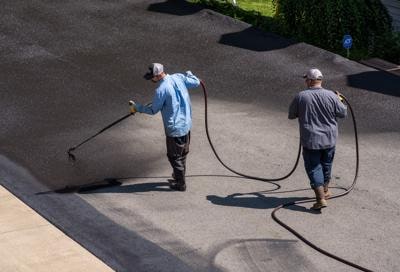Optimize Toughness: Warm Mix Asphalt Sealing for Angled Parking Frameworks
Optimize Toughness: Warm Mix Asphalt Sealing for Angled Parking Frameworks
Blog Article
Warm Mix Asphalt: A Lasting Remedy for Sidewalk
Warm Mix Asphalt (HMA) has actually emerged as a leading lasting option for sidewalk options, using a myriad of environmental advantages and cutting-edge modern technologies. Its capability to decrease and recycle materials energy intake offers a compelling situation for its adoption in road construction tasks. In addition, the long-term efficiency and longevity of HMA make it a recommended alternative for facilities advancement. As the demand for environmentally friendly building practices grows, exploring the nuances of HMA's sustainability can offer useful understandings right into the future of pavement solutions.
Ecological Benefits of Warm Mix Asphalt

Furthermore, Warm Mix Asphalt assists to mitigate metropolitan heat island impacts. Its dark shade takes in sunshine, reducing the amount of warmth reflected back right into the ambience compared to lighter-colored pavements. This can lower ambient temperature levels in urban locations, decreasing the demand for air conditioning and inevitably decreasing power consumption.
Furthermore, Warm Mix Asphalt adds to improved stormwater administration. Its permeable nature allows water to penetrate the sidewalk and reenergize groundwater products, lowering runoff and the risk of flooding. These environmental benefits make Warm Mix Asphalt a lasting selection for leading roads and highways.
Energy Efficiency in HMA Production
Is energy efficiency an important variable in the production of Hot Mix Asphalt (HMA)? Power plays a substantial function in the production of HMA, influencing both price and ecological sustainability. One crucial aspect of power effectiveness in HMA production is the usage of cozy mix asphalt (WMA) innovations.
Additionally, advancements in plant modern technologies have caused more energy-efficient HMA manufacturing processes. Modern plants are designed with attributes like recycled asphalt sidewalk (RAP) processing capacities, reliable burner systems, and enhanced insulation, all adding to power cost savings. By enhancing power usage in HMA production, the sector can decrease its carbon impact while preserving top notch sidewalk materials. Power effectiveness is, therefore, a crucial factor to consider in making sure the sustainability of Hot Mix Asphalt manufacturing.
Recyclability of Warm Mix Asphalt
The recyclability of Warm Mix Asphalt (HMA) is a critical facet of its sustainability and long-term ecological influence. HMA is among one of the most recycled materials in the United States, with over 100 million lots of reclaimed asphalt sidewalk (RAP) being reused each year in new pavement building. Reusing HMA offers a number of ecological advantages, such as reducing the need for virgin materials, decreasing power consumption during production, and reducing the amount of waste sent to landfills.
The procedure of reusing HMA entails milling the existing sidewalk, crushing it into smaller pieces, and mixing it with new accumulation and asphalt binder to produce a recycled mix. This recycled mix can usually perform as well as or perhaps much better than conventional HMA, while requiring fewer resources and producing lower greenhouse gas discharges. By including RAP into brand-new sidewalk jobs, roadway agencies can conserve natural deposits, reduce costs, and minimize the ecological footprint of road building and maintenance tasks. Overall, the recyclability of HMA plays a considerable role in promoting lasting techniques within the sidewalk sector.

Long-Term Efficiency of HMA
Asphalt find more sidewalks demonstrate resilience and resilience over a prolonged period, showing the long-term efficiency of Hot Mix Asphalt (HMA) Additionally, innovations in HMA innovation, such as the usage of polymer-modified binders and warm mix asphalt, have actually further improved the toughness and long life of HMA pavements. By focusing on high quality building and construction and maintenance methods, HMA continues to prove itself as a lasting and cost-efficient service for durable pavement facilities.

HMA: Resilience and Sustainability
Showing both longevity and sustainability, Warm Mix Asphalt (HMA) has come to be a cornerstone in the building and construction of resilient pavement frameworks - commercial parking lot paving. HMA's toughness comes from its capacity to stand up to heavy tons, rough weather condition conditions, and high website traffic volumes, making it a reliable option for roadways, freeways, and airport paths. The composition of HMA, which normally includes aggregates, binder, and filler, plays an important duty in enhancing its longevity and resistance to tear and wear
Furthermore, HMA's sustainability depends on its recyclability and energy-efficient production process. The capacity to reuse recovered asphalt sidewalk (RAP) in new HMA mixes lowers the demand for virgin materials and reduces the environmental impact of pavement building and maintenance. Furthermore, the power efficiency of creating HMA depends on its lower mixing temperatures contrasted to various other pavement materials, causing More hints lowered energy consumption and greenhouse gas discharges.
Conclusion
In verdict, warm mix asphalt (HMA) uses a lasting remedy for sidewalk with its eco-friendly features. HMA's recyclability, energy performance in manufacturing, and lasting durability make it a green selection for road building and construction. By conserving natural resources, decreasing waste, and decreasing greenhouse gas discharges, HMA plays a critical duty in advertising sustainability in framework growth. Its capability to minimize city warm island effects even more underscores its significance in creating eco mindful and durable sidewalk systems.
HMA is one of the most recycled materials in the United States, with over 100 million tons of redeemed asphalt discover this info here pavement (RAP) being recycled yearly in new sidewalk construction.The process of recycling HMA includes grating the existing pavement, crushing it right into smaller pieces, and blending it with brand-new accumulation and asphalt binder to produce a recycled mix.Asphalt sidewalks demonstrate resilience and strength over a prolonged period, showing the long-term efficiency of Hot Mix Asphalt (HMA) Additionally, innovations in HMA modern technology, such as the use of polymer-modified binders and warm mix asphalt, have actually better improved the durability and durability of HMA pavements. The capability to recycle recovered asphalt pavement (RAP) in new HMA mixtures minimizes the demand for virgin materials and decreases the environmental effect of sidewalk building and construction and maintenance.
Report this page